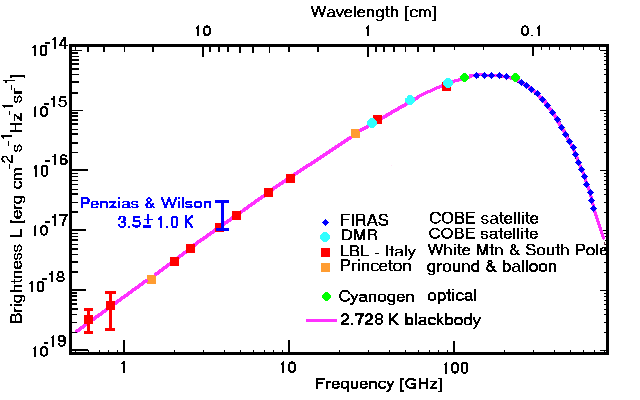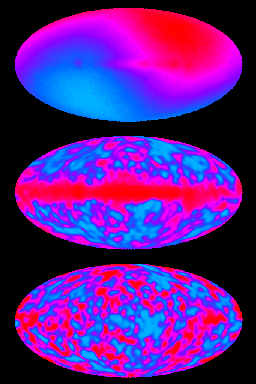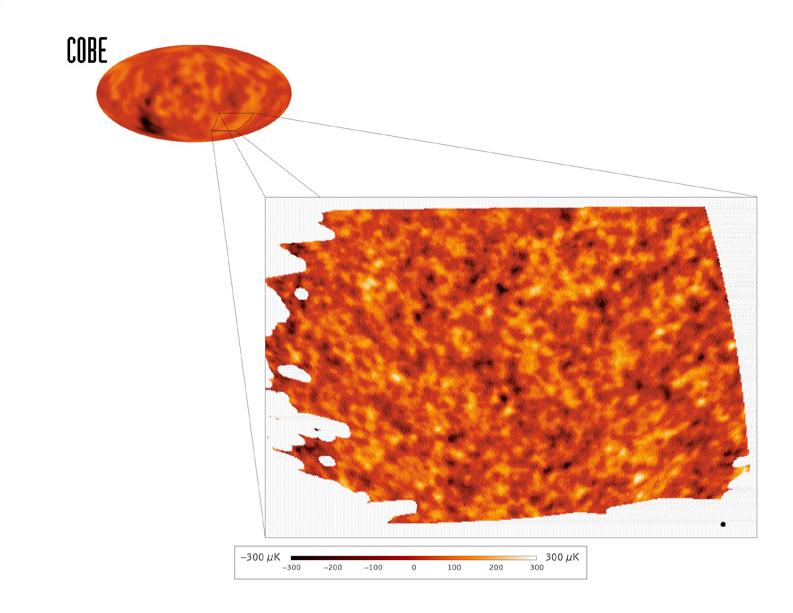8. THE COSMIC MICROWAVE BACKGROUND (CMB)
Gamow's triumph: In Section
2 of this lesson you can find a chronicle of the discovery
of the cosmic fireball radiation. It is surely one of the most fascinating stories
in the history of science. Be sure to review it.
As we have described, George Gamow's theory of the hot big
bang was wrong. Gamow overlooked the most important reactions that determine
the formation of elements in the early universe and his prediction of the temperature
of the cosmic fireball radiation was off by a factor of almost 10. Yet we attribute
the theory of the big bang universe to Gamow, and rightly so. He was the first
scientist who dared to try to explain what the universe was like when it was
only minutes old, and he realized that it must be filled with gamma rays in
order to prevent nuclear reactions from turning all the matter into heavy elements.
Gamow led the way by asking the right questions. After that, it was inevitable
that other scientists would check his theory and correct the errors. And several
did, apparently without knowing of each other's work.
George Gamow came to the University of Colorado from Washington
University in 1956. He was a great popularizer of science as well as a great
scientist. During the 1950s he wrote many books about astronomy, mathematics,
and other branches of science intended for students at every level, from elementary
to college.
Thermal history of the universe:
According to the big bang theory, the universe at an age of 1 second A.B.E.
is filled with radiation at a temperature of about 1010 (10 billion)
K. As the universe expands, this radiation (and the matter) will cool down.
By 300,000 years A.B.E., the cosmic temperature will be 3700 K, roughly the
temperature of the photosphere of a red giant star.
A very important transition in the history of the universe occurs
at this time, which we call the recombination
epoch. Before this time, almost all the hydrogen atoms in
the universe are ionized, so that the cosmic gas consists of bare protons and
electrons, plus helium atoms. In such a gas, just as in the Sun's interior,
a photon cannot travel far before it scatters off a free electron in the gas.
The result of this diffusion is that the universe is opaque: we cannot tell
where the photons were originally produced. But after the recombination epoch,
the temperature is low enough that the electrons can attach to protons and remain
bound to form neutral hydrogen atoms.
The photons of the cosmic background radiation, now consisting
mainly of red and infrared photons, do not interact with the neutral hydrogen
and helium atoms. At the recombination epoch, the universe becomes transparent.
The photons that we detect in the microwave background today have traveled freely
through cosmic space since the universe was only 300,000 years old. In a very
real sense, the universe before the recombination epoch was like the interior
of the Sun: hot and opaque. The universe after the recombination epoch is more
like interstellar space: cool and transparent. Because of this analogy, we speak
of the place where the radiation last interacted with matter as the cosmic photosphere.
As the universe continued to expand, the cosmic background continued
to cool and the wavelengths of the photons continued to increase. According
to this theory, the temperature of the cosmic background should be about 3 K
at the present time.
Spectrum: In 1965, Penzias
and Wilson measured a background radiation temperature of 3.5 +/- 1.0 K. At
that time many scientists were not convinced that they were really seeing the
radiation from the big bang. A crucial test would be to see whether the background
radiation actually had the spectrum of blackbody radiation that was predicted
by the theory. That test required observations of the radiation at wavelengths
shorter than 2 millimeters, which could only be done from space. (The Earth's
atmosphere is too bright to make such measurements from the ground.)
The issue was settled by observations with the Cosmic Background
Explorer (COBE) satellite, launched in 1989. COBE observations showed that the
background radiation spectrum at wavelengths less than 3 mm fit the theoretical
blackbody curve to an accuracy of better than one part in 1000.
Actually, the temperature of the microwave background had already
been measured in 1941 by Andrew McKellar indirectly through observations of
optical absorption lines due to the cyanogen (CN) molecule in interstellar clouds.
Each CN molecule acts as a tiny antenna that is tuned to absorb radiation at
wavelengths of 2.64 and 1.32 mm. One can infer the intensity of this radiation
by measuring the relative intensities of optical absorption lines due to these
CN molecules. But in 1941 there was no theory of the big bang radiation, so
few people paid any attention to the observation, and nobody recognized its
significance until 25 years later.
In fact, since the late 1940s, millions of people had been observing
the cosmic microwave background every day without knowing it. TV receivers are
sensitive to radiation with wavelengths in the range 10 - 20 centimeters, and
about 1% of the "snow" on every TV screen is due to this radiation.
The figure below summarizes the observations of the microwave
background radiation. You can see that the temperature of the background radiation,
originally measured to be 3.5 +/- 1.0 K, is now known to be 2.728 K, with an
accuracy better than one part in 1000.
|

|
|
Spectrum of the cosmic microwave background. The various modern
observations fit exactly on the violet curve, which represents the radiation
from a perfect blackbody with a temperature of 2.728 K. The blue bar
represents the original 1965 measurement by Penzias and Wilson. The
green dots represent the 1941 measurement by McKellar.
|
Isotropy: the
big bang theory not only predicts that the microwave background radiation should
have a blackbody spectrum, it also predicts that the radiation should be isotropic
-- i.e., that it should have the same intensity in every direction. We shall
see that measurements of the angular distribution of the microwave background
have become powerful tools for understanding the origin of structure in the
universe. The figure below shows the results from COBE.
|

|
Top: light blue to red represents an increase in radiation temperature
of a few parts in 1000. The radiation is slightly warmer toward the
upper right because the solar system is moving in that direction with
a velocity of about 600 km/s. This variation is called the "dipole asymmetry."
|
|
Middle: the dipole asymmetry has been subtracted and the scale has
been changed so that light blue to red now represents an increase in
radiation temperature of only a few parts in 100,000. The dominant feature
is the glow of dust from the Milky Way.
|
|
Bottom: The radiation from the Milky Way has been subtracted. The
residual fluctuations represent the temperature fluctuations of the
"cosmic photosphere" when the universe was about 300,000 years old.
|
|
The cosmic microwave background as observed by the
COBE satellite
|
The COBE satellite could not measure
fluctuations in the microwave background with angular size less than about 7o,
the diffraction limit of the telescope (see Angular
Resolution). Fluctuations with smaller angular size
were blurred beyond recognition. But very recently, in April 2000, a team of
astronomers reported results of measurements of the microwave background made
with a larger telescope carried on a balloon launched from Antarctica -- see
the Boomerang
home page. Their results show even stronger fluctuations on angular scales of
about 1o, as illustrated below. In these new measurements, the blurring
of the fluctuations is caused by the universe itself, not by the telescope.
|

|
|
The angular fluctuations of the CBR as measured by the Boomerang
experiment (inset at right) compared to the fluctuations observed by
COBE (upper left). The bright and dark patches in the Boomerang data
differ in temperature from the average by approximately one part in
10,000.
|
In the past few years, several other groups have made similar
measurements of the cosmic microwave background radiation, and they have confirmed
and refined the results described above. To go deeper into the physics of the
cosmic microwave background radiation, see The
Physics of Microwave Background Anisotropies, by Wayne Hu.
We can draw two basic conclusions from these observations:
- The temperature of the cosmic photosphere is extremely
smooth. (Unlike the Sun's photosphere, where the temperature ranges from
about 6000 K to 4800 K in sunspots.)
- The temperature is not perfectly smooth: it varies by about
1 part in 10,000.
Both of these conclusions have profound implications, as we shall
now discuss.
(Return
to course home page)
Last modified April 14, 2002
Copyright by Richard McCray

